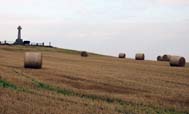Synopsis (from the back of the book):
During the reigns of Elizabeth I and James I it was high treason, and therefore meant death, to be a Catholic priest in England. It was consequently vital that there be somewhere to hide when the pursuivants came battering at the door. One name is prominent in the construction of priest-holes – that of Nicholas Owen. A very short and later crippled man, he built the majority of these shelters, so saving the lives of untold numbers of priests and fugitives. His early apprenticeship as joiner and his knowledge of construction served him will as he burrowed into walls and constructed near-invisible entrance holes. Although a well-know figure in Recusant studies, and almost invariably mentioned in histories of the Gunpowder Plot, this is his first detailed biography.
St Nicholas Owen was born in Oxford, the son of a carpenter. Two of his brothers were to train as Catholic priests on the continent. A third, Henry, the first apprentice at what was to become the Oxford University Press, went on to assist the Mission with the production of Catholic books and pamphlets. Nicholas was himself apprenticed to and Oxford joiner in 1577.
Acting as a servant to Fr Henry Garnet SJ for nearly twenty years, Owen had many adventures, narrowly evading capture, and assisted in the escape of the Jesuit Fr John Gerard from the Tower of London in 1597. St Nicholas was tortured at the Poultry Compter in 1594 but later released. He was finally taken in one of his own priest-holes during the rigorous pursuit of Catholics that followed the failure of the Gunpowder Plot, and died upon the rack in the Tower of London in 1606.
Evidence of St Nicholas Owen’s work is still visible in contury houses and mansions across England, and recent research has unveiled greater detail of his fascinating career assisting the English Mission aat the close of the 16th and beginning of the 17th centuries.
Review:
This fascinating account of both Nicholas Owen and his construction of priest-holes is well worth a read. The book also gives accounts of Jesuit priests and the Catholic families that helped and concealed them from pursuivants. The content is quite graphic at times, detailing hanging and torture procedures. We are told of Nicholas’ early life, his work in creating the hides right through to his torture, death and beyond to when he became one of the forty-martyr saints who received canonization in 1970. The book is fully illustrated with black and white photographs and diagrams of the hides, houses and some of the key players of this period in history.









Weird? Today’s picture is not showing?
Thanks for letting me know
I had been experimenting with with uploading pics to my blog rather than linking to them from Flickr. For some reason the post link had chosen to revert to an earlier saved version of the post rather than the one I had actually tried to post…
You should be able to see the picture now?
I look back at those days and sit in awe at the courage of such men. As an Englishman and a Catholic I weep for the people (all people) of that turbulent and violent time when Englishmen let leave of their sense of common purpose and common, traditional spiritual certainty; and all at the behest of a King who could have been the greatest Catholic King in several hundred years, but fell to the corrupt desires whispered into his ear by ‘you know who’.
Owen’s constructions remind us of a time past. His material works have stood the test of time, at a time when the entire country’s traditions and ways of living were being hunted down and destroyed. His spiritual work lives in eternity.
And now our time is seeing worse coming in the near distance.
Those men are incredibly inspiring and so are the women that risked their lives to conceal them.
The sad thing is that the human race never learns from its past mistakes it justs goes on to repeat them all over again.
Thank you for a reference no-one else had mentioned. This was a topic I was very interested in so I created a link to my post called “Terror and Catholic faith in Elizabethan England”. http://melbourneblogger.blogspot.com.au/2015/05/terror-and-catholic-faith-in.html
Hels
Thanks for the link back
-The books that Tony Reynolds main sources are:
-The Autobiography of a Hunted Priest translated by Philip Caraman
-The Conditions of the Catholics under James I edited and translated by John Morris (this includes the Autobiography and another work by John Gerrard; Narrative of the Gunpowder Plot)
-Henry Garnett 1555-1606 and the Gunpowder Plot by Philip Caraman
-God’s Secret Agents by Alice Hogge (for information on the activities and fates of the missionary priests)
-The Gunpowder Plot – Terror and Faith in 1605 by Antonia Fraser (being more sympathetic to the Catholics than most)
-Secret Hiding Places by Michael Hodgetts (for details of the hiding places)
There is an earlier work on priest holes. Secret Chambers and Hiding Places by Alan Fea which can be read on line at library.org https://archive.org/details/secretchambershi00feaa
I have previously written a review on the Autobiography of a Hunted Priest. http://www.cheriesplace.me.uk/blog/index.php/2015/05/25/the-autobiography-of-a-hunted-priest-john-gerard/
Wow, sounds like a fascinating tale. It’s just incredible that these events were actually real and not imagined. Who needs fantasy when humans are capable of the more extraordinary things?
It is quite shocking that these things happened and similar still continue to do so.